ENTER YOUR EMAIL TO RECEIVE OUR WEEKLY NEWSLETTER
Art on the Go: In the NYC Subway (of all places)
The trains may be crowded and delayed, but hey—the platforms are morphing into art galleries
By George Gelles
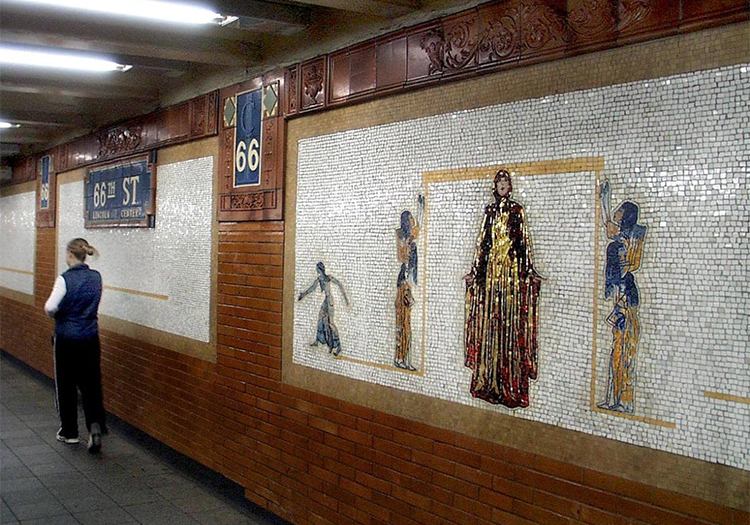
Updated March 3, 2024
So begins the quotidian ritual, a rite observed since 1904, when automated people-movers began crawling beneath the crust of Manhattan, carrying cargoes of travelers, dozens at once. Subways, they were called, and in time—along with the Model T, the first Ford designed for a mass market, which debuted in 1908—they replaced the horse and buggy once favored by Victorians and later by Edwardians.
Nowadays we’re modern and we know how it goes: One of a throng, you wait on a platform, which, in truth, is a loading dock such as those that cattle crowd, on their way to slaughter. There’s a premonition—you hear the train tracks shudder in their braces below, down where the brown rat lives; the brown rat, rattus norvegicus, is our rat and is celebrated online as a cultural symbol of the city. Roll over Beethoven…and Sondheim, Bernstein, and Dylan, too.
Momentarily, you feel a whoosh of air slap your face, a blast the approaching behemoth pushed out of its tunnel. Then the train rumbles in, possibly on time, probably not. If it’s rush hour, a.m. or p.m., you charge the car elbow first to carve a spot where you’ll stand immobile, in intimate proximity with a total stranger, perhaps even closer than to last night’s hook-up. If it’s between rush hours, you sit fearsomely alone.
It’s a Monday-to-Friday routine, and on an average day, despite attrition due to Uber and Lyft and the like, about four million subway trips are taken throughout four of the city’s five boroughs. Sorry, Staten Island, no subway for you, though there’s a street-level Staten Island Railway, a subsidiary of the Metropolitan Transit Authority, which governs the subways, plus a comprehensive web of bus services, and a super-cool ferry that goes to Lower Manhattan.
Moms and dads; elementary school kids, high school kids and college kids, too; house builders and homewreckers; moviemakers and film fans; attorneys and parties guilty or innocent; master chefs, sous chefs, and bottle washers; average Joes and Janes—they all play a part in the pageant we might call the Commuter Kabuki.
But the stations! Though the rolling stock is air-conditioned, or purports to be, not one station among the system’s almost 500 enjoys this amenity. In the winter they’re an icebox; in summer, a shvitz. The stations, in a word, are a mess.
Or are they?
In 1985, as part of its initiative to refresh and refurbish the system, the Metropolitan Transit Authority created MTA Arts for Transit and Urban Design, now known as MTA Arts & Design. Over the years through a competitive process, the program has commissioned more than 300 artists to create original works in various materials: ceramic tile, bronze, steel, and glass. Most art works are in subway stations, though some are within subway cars or on out-of-doors waiting platforms, and many are site-specific.
Though it’s impossible to acknowledge the full brilliance of the program’s progeny, here are a few of my favorites:
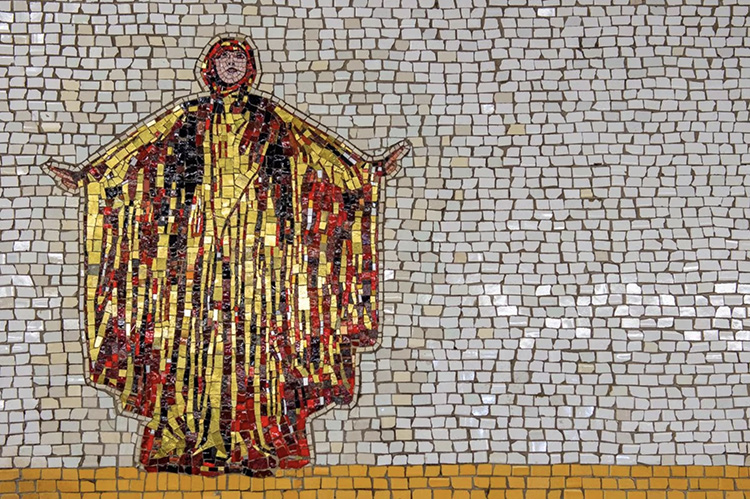
A mosaic figure opens her arms in Nancy Spero’s “Acrobats, Divas and Dancers,” at the 66th Street 1 train station. Photo: Trent Reeves.
. . . . . . . . . . . . .
Nancy Spero’s Artemis, Acrobats, Divas, and Dancers are glass mosaic murals created in 2004. Reflecting Spero’s fascination with Roman and Etruscan frescoes, the figures depict fanciful scenes evoking music, dance, and drama. Appropriately, they adorn the walls of the 66th Street 1 line station, serving Lincoln Center.
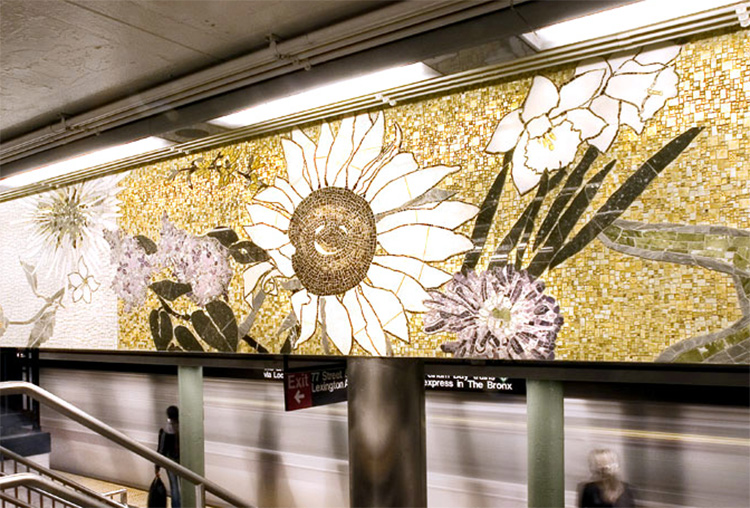
Botanicals bloom in Robert Kushner’s “4 Seasons Seasoned,” at the 77th Street 6 train station. Photo: Rob Wilson.
. . . . . . . . . . . . .
Also deeply impressive is Robert Kushner’s 4 Seasons Seasoned, likewise from 2004. These are super-sized mosaic murals that exemplify Pattern and Decoration, the movement the artist can be said to have founded. We’re overwhelmed by a panorama of flora far larger than life—flowers and plants of all descriptions. They reveal Kushner’s reverence for Japanese precedent and form a counterpoint to the above-ground urban landscape. They’re found at the 77th Street station on the East Side’s 6 line.
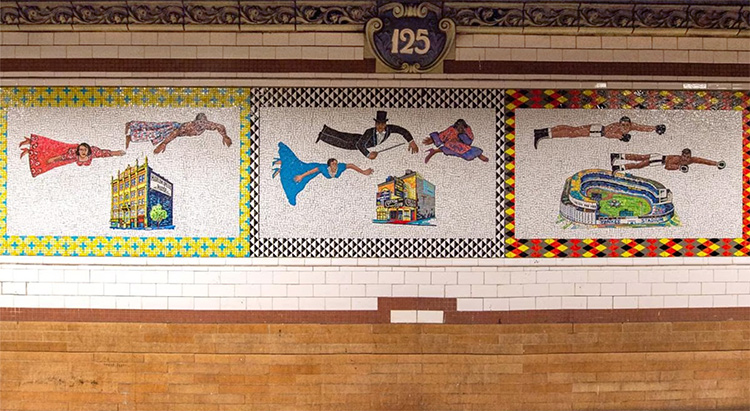
Icons are airborne in Faith Ringgold’s “Flying Home: Harlem Heroes and Heroines (Downtown and Uptown)” at the 116th, 125th, and 135th Streets 2 and 3 train stations. Photo: Trent Reeves.
. . . . . . . . . . . . .
Faith Ringgold does everything, everywhere, all at once—she paints and sculpts and makes quilts that are out of this world, and she does so with exuberant intelligence. Her mosaic entitled Flying Home: Harlem Heroes and Heroines, from 1996, was inspired by “Flying Home,” a Lionel Hampton classic from 1940, recollected from her childhood. In this whimsical homage to Harlem, her birthplace, we meet writers, visual artists, musicians, icons of sports, champions of civil rights, and more. They’re all in flight, and their airborne disposition is itself a flight of fancy, as her mural is tripartite, with episodes at the 116th, 125th and 135th Street stops on the West Side’s 2 and 3 lines.
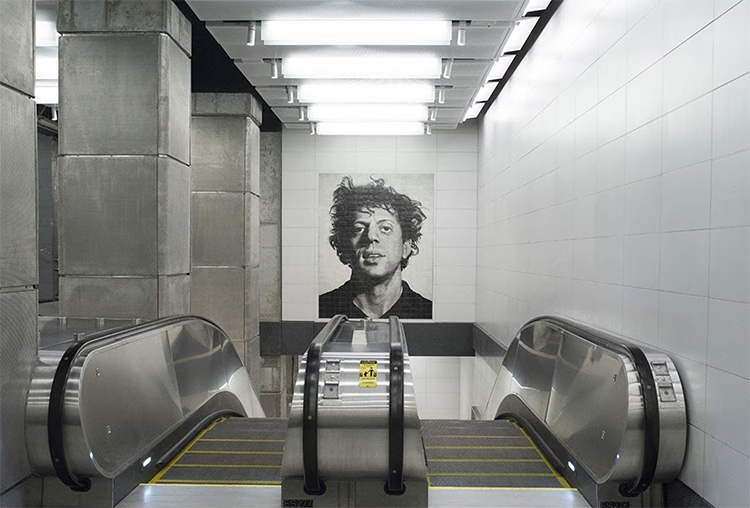
A supersized Philip Glass awaits at the escalators in one of Chuck Close’s “Subway Portraits,” at the 86th Street Q train station. Photo: Nafis Azad.
. . . . . . . . . . . . .
Chuck Close, another headliner, created a suite of a dozen Subway Portraits mosaics in his signature style, oversized and super-realistic. His subjects are friends and colleagues, and include, among others, musician Lou Reed, composer Philip Glass, and fellow artists Kara Walker and Alex Katz, as well as Close himself. Installed in 2016, the Portraits are found at the 86th Street station of the recently built Second Avenue Q train line.
In its mix of artists who work in all media and who represent all personal persuasions, the MTA Arts & Design collection is a treasure. In interest and enjoyment, aesthetic pleasures and spiritual rewards, it easily equals its kindred above-ground institutions. It’s the city’s subterranean art museum non pareil, and in verve and vision, one that no other city can match.
George Gelles was the dance critic of The Washington Star from 1970 to 1976 and the author of A Beautiful Time for Dancers. He thinks of himself basically as a musician—a horn player—who just happened not to play professionally for 37 years. Gelles has also written about music and dance for The New York Times, The New Grove Dictionary of Music and Musicians, and Musical America, and lectured on music and dance at the Smithsonian, George Washington University, and the San Francisco Conservatory of Music. And from 1986 to 2000, he was the executive director of San Francisco’s Philharmonia Baroque Orchestra.
You may enjoy other stories by George Gelles:











